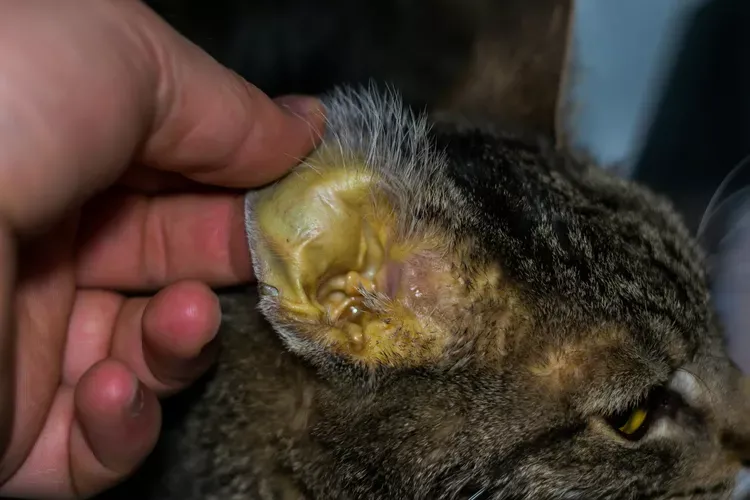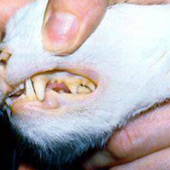Liver problems in your cat

Liver problems in your cat
Cats are susceptible to liver illness at any age, from kittens to elderly adults, and it is rather frequent. Like many other diseases in cats, liver disease usually has hazy symptoms; affected cats are frequently quiet, lose weight, and have decreased appetite. Jaundice is a common condition in cats, and if your cat has it, you can observe yellowing of the eyes, mouth, or skin, as well as darker-than-normal urine.

Why does a cat get liver disease?
Large and located in the front of the belly is the liver. Its functions are diverse, but they are all typically related to metabolism, which is the process by which the body produces substances that are helpful to it and processes and safely removes a variety of waste products and poisons.
Numerous illnesses can damage the liver, and each one has its unique reasons. Porto-systemic shunt patients' animals' livers receive aberrant blood supplies. This is a hereditary disease that is more prevalent in Devon Rexes, Cornish and Persian dogs, and other kindred breeds. Typically, kittens and young adults exhibit symptoms.
The horrible virus that causes Feline Infectious Peritonitis (FIP) can afflict young cats. In addition to other bodily diseases, cats with FIP may experience liver illness. Some cats, especially Persians and kindred types, have cysts in their livers. There is an ultrasound examination program and a genetic test available for polycystic kidney disease (PKD), which is exacerbated by these cysts. Currently, breeders are working to eradicate this illness. Liver disease can happen at any age and is sometimes caused by toxins and damage from septicemia. Liver illness is a condition that some cats with Feline Immunodeficiency Virus (FIV) experience.
The most prevalent liver diseases are those that typically affect middle-aged and older cats: hepatic lipidosis (fatty liver), which occurs when the liver function shuts down as a result of another serious illness like diabetes (or anything that makes the cat stop eating); and cancers like lymphoma or adenocarcinoma. Inflammatory diseases like cholangiohepatitis and lymphocytic cholangitis are also common. The exact cause of the disease is unknown, however cats that are overweight are more likely to acquire fatty liver, and cats that are exposed to the Feline Leukemia Virus (FeLV) are more likely to develop lymphomas.
The blood test results of cats with diabetes mellitus and hyperthyroidism, two other frequent disorders, typically show evidence of liver damage. When the underlying problem is under control, the alterations in both of these disorders should go away, and therapy for liver damage is not necessary.
Common Liver Problems in Cats
-
Hepatitis: Hepatitis in cats can be caused by infections, toxins, or autoimmune diseases. It leads to inflammation of the liver tissue, impairing its function and potentially causing long-term damage.
-
Fatty Liver Disease (Hepatic Lipidosis): This condition occurs when excessive fat accumulates in the liver cells, disrupting normal liver function. Fatty liver disease is often linked to obesity, sudden loss of appetite, or underlying illnesses.
-
Hepatic Encephalopathy: Liver problems can lead to the accumulation of toxins in the bloodstream, affecting the brain. Hepatic encephalopathy can cause neurological symptoms, such as disorientation, seizures, and behavioral changes.
-
Liver Tumors: Cats can develop both benign and malignant tumors in the liver. These tumors can interfere with liver function and cause a range of symptoms depending on their size and location.
How would I know if my cat has liver disease?
Many symptoms might be displayed by cats with liver illness. The symptoms are frequently hazy and might be mistaken for indications of illnesses in other organs, including as cancer, heart failure, kidney failure, intestinal inflammatory diseases, or heart failure. In addition to generally losing weight and having a decreased appetite, cats may also appear quiet and detached from their typical activities. There might be some vomiting and occasionally diarrhea, which usually consists of bigger amounts of liquid feces.
Cats with portosystemic shunts may exhibit strange behavior, seizures, poor growth, or weight loss as indicators of aberrant brain activity.
A bloated abdomen is a common symptom of various liver diseases, often caused by fluid accumulation but also occasionally by liver enlargement. Again, in addition to liver illness, there are numerous other reasons why fluid can accumulate in the belly.
When cats have more severe liver disease, jaundice is frequently observed, and owners occasionally become aware of this. Wherever your cat's skin is exposed, such as in the space between their eyes and ears, on their ears, on their lips, or on their nose, you can see a yellow tint to their skin. You might also notice that their urine is darker than usual in these areas.
Other issues besides liver disease can also result in jaundice, particularly in cases where red blood cells have been rapidly metabolized (as in the case of cats with Feline Infectious Anaemia (FIA)). Another reason is pancreatitis, or inflammation of the pancreas, but cats that have this condition frequently also have secondary liver damage.
Common Signs and Symptoms of Liver Problems
- Loss of Appetite: Cats with liver problems often lose interest in food and may experience weight loss.
- Jaundice: Yellowing of the skin, gums, and whites of the eyes due to the buildup of bilirubin, a yellow pigment.
- Vomiting and Diarrhea: Digestive disturbances are common in cats with liver issues.
- Increased Thirst and Urination: Liver problems can affect the kidneys, leading to increased thirst and urination.
- Lethargy: Cats with liver problems may appear weak, tired, and less active than usual.
- Behavioral Changes: Cats might exhibit changes in behavior, including aggression or excessive grooming.
Why can't my vet just prescribe some treatment over the phone?
The last paragraph should have made it very evident that a phone call cannot be used to diagnose liver disease. It is undoubtedly impossible to determine its cause. To diagnose your cat, your veterinarian will need to examine it, and more testing is frequently required. When sick cats undergo routine blood testing, it may be possible to detect liver damage. To determine whether the liver is functioning normally, a bile acid stimulation test is performed on the patient. To help diagnose FIP, FeLV, FIV, and FIA and to look for other causes of abdominal fluid buildup, additional laboratory testing is performed. Ultrasound liver scanning is a widely utilized technique that can help your veterinarian detect tumors and cysts. The majority of liver disorders are caused by cancer and inflammation, and the only way to identify these conditions is to obtain a tissue sample, which can be taken during surgery, with ultrasonography guidance, or with a tiny needle.
Can liver disease be treated?
Drugs are an excellent treatment for some liver illnesses; common inflammatory diseases react well to pharmacological therapy and are frequently administered for weeks, months, or even life. Often, the prognosis is favorable. Special diets are frequently beneficial.
Although rare, some liver illnesses necessitate surgery. For example, emergency surgery is needed when bile tract stones cause an obstruction. Sometimes, individual cysts and tumors can be removed.
Regretfully, certain liver conditions do not improve with medication. There are no effective treatments for PCOS, or FIV illnesses. Liver cancer is a frequent malignancy for which chemotherapy may be effective, but favorable results are not typical.
Even with malignant liver cancer, cats can live a long time with the disease provided that their condition is managed and that their level of illness at diagnosis is taken into consideration.
Treatment for liver problems in cats depends on the underlying cause and the severity of the condition. It may include:
-
Dietary Management: A specialized, easily digestible diet tailored to support liver function may be recommended.
-
Medications: Veterinarians might prescribe medications to alleviate symptoms, manage infections, or reduce inflammation.
-
Fluid Therapy: Intravenous fluids can help maintain hydration and support overall organ function.
-
Nutritional Support: In cases of appetite loss, your vet may recommend syringe feeding or a feeding tube to provide necessary nutrients.
-
Surgery or Interventional Procedures: In some cases, surgery or other procedures might be necessary to remove tumors or address specific issues causing liver problems.
-
Regular Monitoring: Cats with liver problems require regular veterinary check-ups to monitor their condition, adjust treatment as needed, and ensure the best possible quality of life.
What happens if I don't get treatment for my cat?
Everything hinges on what is causing the issue. Most cats may not exhibit symptoms of mild liver disorders, therefore any liver condition severe enough to manifest at home is unlikely to improve on its own. Blood tests from cats being evaluated for other reasons occasionally reveal evidence of liver damage; if there isn't a clear liver issue, monitoring may be sufficient. To get more details, your veterinarian might wish to run further tests, like an ultrasound and the bile acid stimulation test.
How can I stop my cat getting liver disease?
It's important to consider that there are many liver disease predispositions. Although it is challenging to avoid FIP, some breeders assert that their kittens are devoid of the causative infection, coronavirus. For cats who have access to the outdoors, vaccination against FeLV is recommended. Since obesity and its connection to hepatic lipidosis are the primary preventable risk factors for liver disease, it is highly advised that your cat be regularly weighed and fed a suitable diet to keep their body condition within the normal range.
Conclusion
Liver disease is always a serious condition that typically requires significant veterinarian involvement. Treatment planning begins with liver disease diagnosis, followed by determining the precise nature, prognosis, and source of the illness. Additionally, the course of treatment can be costly and complex, frequently involving lengthy drug regimens and hospital stays for supportive care. Forced tube feeding is frequently crucial. To increase the number of cats who survive common treatable liver disorders, maintaining the cat's nutrition is essential. It's critical to get the diagnosis as soon as possible since some cats have terminal illnesses for which death at the appropriate time would be the most humane course of action. In these cases, it is not ethical to provide a cat all of this veterinary care.


